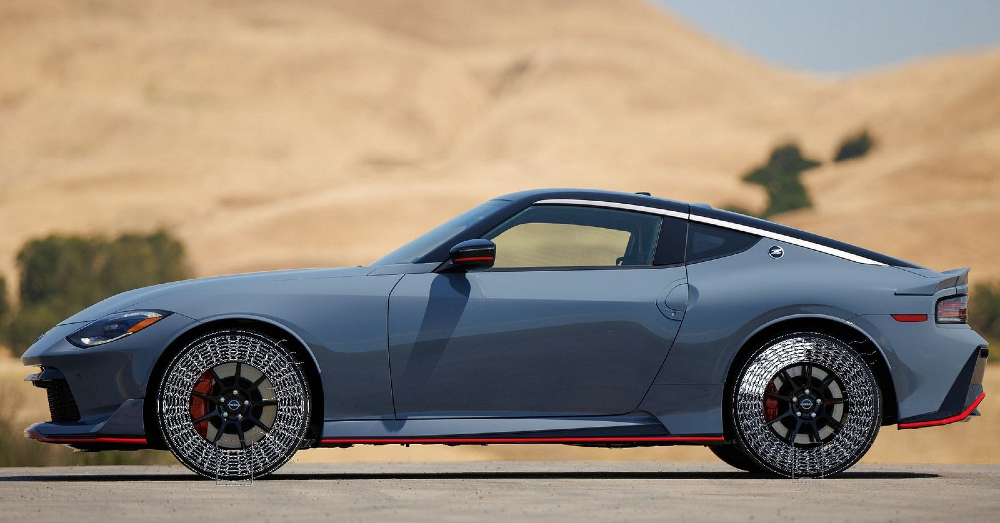
Experience Innovation with Nissan’s Ground-Breaking Airless Tires
Nissan is ready to give the world airless tire technology that should be far beyond what some tire manufacturers already created.
Why do we need airless tires when the current solution works so well? The new Euro 7 emissions regulations aim to restrict the amount of particulate emissions from brakes and tires, which means a new solution is important. Although automakers won the battle against these new regulations, no changes were made, and the new Euro 7 restrictions will go into effect soon. This means automakers need to be ready to have solutions to the particulate problem of tires and brakes.
What has Nissan created?
The Nissan airless tire technology is similar to that already presented by some tire manufacturers, with a bit of a twist on the idea. These tires are interesting to see because they don’t have enclosed sidewalls like traditional tires. The lack of a sidewall means you can see what’s going on, but this also allows a larger contact patch between the tire and the road. This new concept is in its early stages of development, but some issues have already arisen, enabling manufacturers to work toward a solution to problems with these tires.
What problems has Nissan found?
Airless tires use a series of spokes arranged in a way to soak up the bumps and bruises on the road while providing adequate grip. The greatest challenge Nissan has found is the load forces on the spokes closest to the ground. One way to solve this problem would be to make the outer part of the tire more robust, but that would reduce the contact patch, defeating the purpose of the new tires. Adding more to the outer sidewall area would reduce the tire’s ability to soak up road issues and make it more difficult for drivers to handle the forces while steering.
Instead of only improving the outer part of the tire, the Nissan airless tires could have a set of elastic spokes radially from the outer side toward the inner part of the tire. This would transfer the load to these spokes, which could enable the exterior of the tread to take on less of the load during driving. This load transfer shares the forces across the entire width of the tires, ensuring the forces don’t stress out one part of the tire more than the rest.
Nissan claims these new airless tires could be applied to all types of vehicles, including industrial vehicles and bicycles. Could this be the future of tires? Maybe.
Will airless tires be more environmentally friendly?
Electric vehicles have been mired with questions regarding their environmental impact. The same might go for these new tires. From the description given, these new airless tires will require extensive changes to the manufacturing process and could require more materials than current tires to build them.
Although these new tires might require more materials to create them, they don’t get punctured and aren’t as easily damaged as traditional tires. This means the tires could last much longer than current tires on most vehicles. If drivers must buy fewer tires over the lifespan of a vehicle, this could be an environmental improvement. Still, that’s not yet proven to be the case.
Ford is already developing wheels that can support airless tires, which could be required in the future. Could this mean new vehicles need Ford wheels and Nissan airless tires to meet the new Euro 7 regulations? Possibly.
What is the current Nissan EV lineup?
These new airless tires could be useful on all types of vehicles, including EVs. Nissan currently only offers two electric vehicle models, but more are planned for the future. The Nissan Leaf continues to be a small and useful hatchback with an affordable price and respectable driving range that’s ideal for commuters and city dwellers.
The latest addition to the Nissan EV lineup is the new Ariya. This new Nissan electric SUV could become the testbed for these new airless tires. The Ariya has already proven its worth with the new e-4orce AWD system, which gives it excellent traction on all types of terrain. The Ariya is a whisper-quiet EV with a good driving range and enough capability to head out on some tough trails when properly equipped.
Goodyear was the first tire maker to offer an airless tire, and Michelin introduced the Uptis after the Goodyear model. Nissan recently filed a patent for its airless tire system with the World Intellectual Property Organization. Which airless tire will come to the market first?
This post may contain affiliate links. Meaning a commission is given should you decide to make a purchase through these links, at no cost to you. All products shown are researched and tested to give an accurate review for you.



